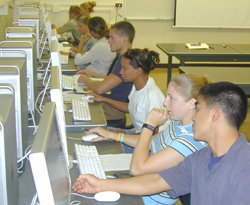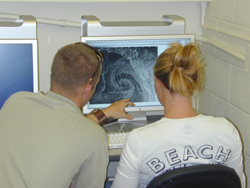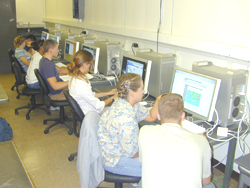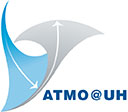About the Department of Meteorology
VisionLab
 With funds from the Unidata Equipment Award Program and a generous cost
match from the School of Ocean and Earth Science and Technology (SOEST), the department has undertaken a significant upgrade
of its VisionLab computer facility. The upgrade comprises ten new Apple Power Mac G5 (8 Dual and 2 Quad) workstations equipped with 23" Cinema High-Definition
Displays. These new workstations replace an aging set of UNIX workstations in varying stages of disrepair. The new Macs are linked to a high-resolution Sony video
projector for lecture presentations and weather briefings.
With funds from the Unidata Equipment Award Program and a generous cost
match from the School of Ocean and Earth Science and Technology (SOEST), the department has undertaken a significant upgrade
of its VisionLab computer facility. The upgrade comprises ten new Apple Power Mac G5 (8 Dual and 2 Quad) workstations equipped with 23" Cinema High-Definition
Displays. These new workstations replace an aging set of UNIX workstations in varying stages of disrepair. The new Macs are linked to a high-resolution Sony video
projector for lecture presentations and weather briefings.
SOEST’s computer network provides high-speed connections and data transfer capabilities. It connects to the UH Manoa campus FDDI campus backbone network, and through that to PACOM wide-area network services, which link Hawai‘i directly with the Far East and the U.S. mainland. Network switches in the Hawai‘i Institute for Geophysics building (HIG) that houses VisionLab have recently been upgraded to one GB capacity. The new hardware has allowed us to take advantage of the enhanced SOEST network bandwidth.
 A significant advantage of the Macintosh operating system architecture is
its unique flexibility. Mac OS X is a UNIX-based operating system that allows the Unidata software set to be available in the lab (e.g., GEMPAK and the IDV), while
at the same time the usual PC software sets are also available to students and faculty providing desktop publishing functionality (e.g., Apple iWorks, Adobe Creative
Suite, MS Office, etc.). Thus, as the instructor for the synoptic lab class, I can load a Keynote or PowerPoint presentation for the day’s lecture
followed by student-led weather briefings presented using imagery and animations produced by the IDV, McIDAS, and GEMPAK, with underlying data driven by an LDM
data feed. The Mac workstations allow for easy online software upgrades and have a relatively low exposure to disruptive viruses which reduces administrative
overhead.
A significant advantage of the Macintosh operating system architecture is
its unique flexibility. Mac OS X is a UNIX-based operating system that allows the Unidata software set to be available in the lab (e.g., GEMPAK and the IDV), while
at the same time the usual PC software sets are also available to students and faculty providing desktop publishing functionality (e.g., Apple iWorks, Adobe Creative
Suite, MS Office, etc.). Thus, as the instructor for the synoptic lab class, I can load a Keynote or PowerPoint presentation for the day’s lecture
followed by student-led weather briefings presented using imagery and animations produced by the IDV, McIDAS, and GEMPAK, with underlying data driven by an LDM
data feed. The Mac workstations allow for easy online software upgrades and have a relatively low exposure to disruptive viruses which reduces administrative
overhead.
| Table 1: Data Streams for the Central and Eastern North Pacific (not comprehensive). Note the cross-disciplinary nature of a number of the data streams. | |
| PacNet | Long-range lightning data |
| Skynet | GPS precipitable water |
| GroundWinds | UV lidar wind profiles |
| UH LAPS | Objective Analyses |
| UH MM5 | Custom NWP Output |
| GOES Satellite | GOES/GMS for Pacific |
| UH Earth Observing Station | NASA & NOAA data |
| UH Infrasound Lab | Infrasound data |
| UH Sea-level Center | Sea-level data |
| UH SWAN | Wave model |
| Hawaii Center for Volcanism | Volcanic emissions |
During non-class periods the Power Macs are used for research. The Mac platform is well suited to the desktop publishing tasks that characterize the production of research papers and student dissertations. A primary research objective of VisionLab is to mitigate the impact of natural hazards on society and industry through improvements in our ability to observe and predict the evolution of these events over the central and eastern North Pacific Ocean. The updated VisionLab allows a number of data streams and products not routinely available through Unidata to be accessed and archived for research and educational purposes (see Table 1). Both the MM5 and the new WRF model have been ported to the Mac platform. Among our research projects is an effort to assimilate long-range lightning data over the data-sparse Pacific into these models.
 In summary, the UH VisionLab has undergone a major renovation promoted by the funds received from the Unidata Equipment Award Program.
VisionLab capitalizes on state-of-the-art Unidata software and the real-time datastream from Unidata to foster a resurgence of geophysical
data in the Meteorology Program at the University of Hawai‘i. The author of this note will be pleased to share with the Unidata community
his experiences in using Apple hardware.
In summary, the UH VisionLab has undergone a major renovation promoted by the funds received from the Unidata Equipment Award Program.
VisionLab capitalizes on state-of-the-art Unidata software and the real-time datastream from Unidata to foster a resurgence of geophysical
data in the Meteorology Program at the University of Hawai‘i. The author of this note will be pleased to share with the Unidata community
his experiences in using Apple hardware.
Images by Dr Steven Businger



